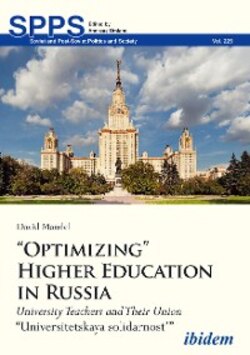Читать книгу “Optimizing” Higher Education in Russia - David Mandel - Страница 5
2. Overview of State Policy a. The Soviet Period
ОглавлениеUniversity teachers were held in high regard in Soviet society, and university teaching was a coveted profession. In that relatively egalitarian system (even considering the privileges of the nomenklatura), a dotsent, the equivalent of a North-American associate professor, the most numerous category of teaching personnel, earned approximately double the average wage and could expect to obtain an apartment. A professor, a title awarded on the basis of major published research, earned double that amount.1 Performance bonuses, beyond the guaranteed part of the salary, were relatively small and stable.
While some research and publishing activity was generally expected, most universities, with the exception of a few élite institutions, focused on teaching, with more advanced research being conducted in the network of institutes belonging to the Academy of Science. Accordingly, while the teaching load could be relatively heavy—300 or more academic hours2 for a dostent (but 120-150 for a professor)—it was manageable. In some institutions, such as Moscow State University, every fourth semester was free for the purpose of research.
Looking back to the Soviet period from 2017, professor of philosophy V. Afanas’eva of Saratov State University recalled: “In the 1980s, when I was pondering a career, to become a professor was not only interesting and respected, but practical too. Indeed, a professor was doing work that he loved. On the face of it, he did not work too much—it looked like a few hours a week. And he received the wage of a Norilsk miner.3 He could allow himself to buy a cooperative apartment in the city’s centre and a dacha on the Volga. And he came to the cashier for vacation pay with a small suitcase, since the money would not fit into a briefcase. Professors were respected, honoured; legends were told about them; each one was unique, irreplaceable, and therefore beloved.”4
There was no concept of tenure in the Soviet Union, but once hired, university teachers could expect to keep their jobs for life, as long as they conformed politically. Party membership, not easy to obtain for intellectuals in the later Soviet period (unlike workers, who sometimes resisted insistent invitations to join), was obligatory in politically sensitive disciplines, such as economics, history, or philosophy, which were under strict ideological control. Sociology, banned under Stalin, was resurrected after his death, but mainly as an applied (fact-gathering and analysis), rather than theoretical discipline. Courses in Soviet Marxism and party history were obligatory for students in all disciplines.
Power in the educational system, as in all social and political institutions, was highly centralized. Organization and financing were decided and administered centrally. In universities and in the more specialized institutes of higher learning subordinated to the various economic ministries, a strong basic education was combined with specialized training that prepared students for future employment. Tuition was free, and students who performed well received stipends, which could easily be supplemented by summer jobs. Employment after graduation in one’s field of specialization was guaranteed—the state’s job assignment was mandatory.5
Teaching personnel in institutions of higher learning, unless they were members of the party committee or held administrative positions, did not participate in important decisions. The most significant decisions were taken centrally beyond the university, including the disciplines and subjects to be taught, admission quotas, educational standards, workloads and remuneration.
The Trade Union of Workers of Education6, Higher Schools, and Scientific Institutions embraced all the employees of these areas, including the administrators. It functioned in practice as an arm of the state and of the local university or institute’s administration. The main focus of their activities was the administration of social benefits. After 1985, especially under Gorbachev’s perestroika, central state control of education was somewhat relaxed, but the union never assumed a significant degree of independence from the university and state authorities, nor did its basic functions change.
The October Revolution opened and greatly broadened access to higher education for the children of workers and peasants, and also for their adult members. And while the state clearly emphasized the role of education in the formation of the skilled labour force required for economic development, it also framed education’s mission in humanistic terms, as favoring the spiritual development of individuals and of society as a whole.7 The downside of this professed humanism was the imposed, crude “ideologization” of higher education, which included mandatory courses in “marxism-leninism,” the history of the Communist Party, and the like.
Soviet parents often invested considerable energy and financial resources in their offspring’s accession to higher education, which was a prestigious and widely-shared goal. Evening and extramural higher education was also widely developed, the law providing special conditions for working students enrolled in these programmes. Students in higher education were generally motivated to learn, since at least equally well-paid jobs not requiring higher degrees were available in industry. For those enrolled in full-time programmes, the university years became a cherished period of their lives, and the friendships established then often endured long afterwards.
